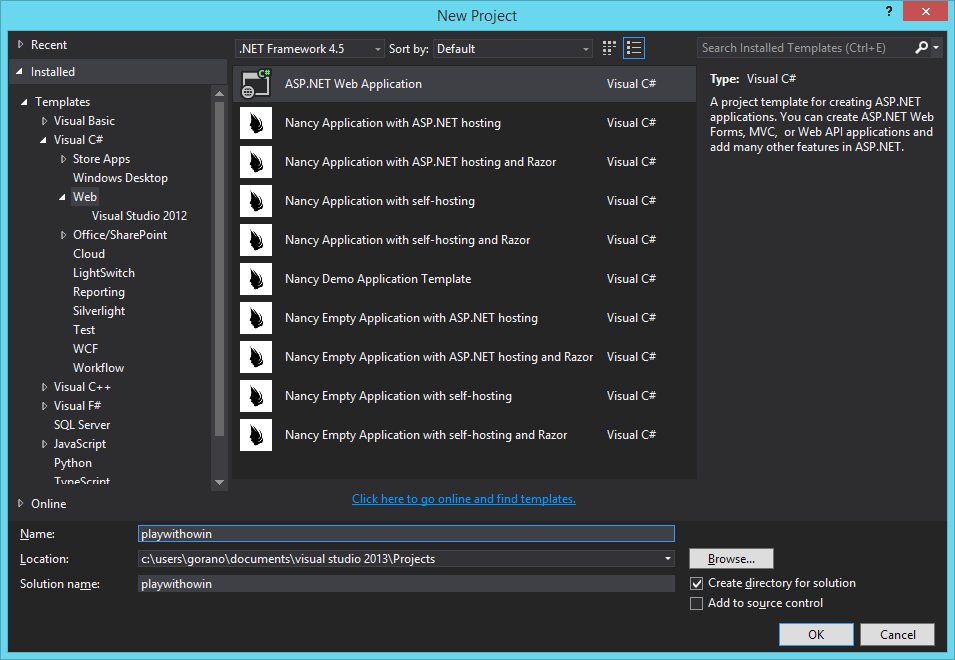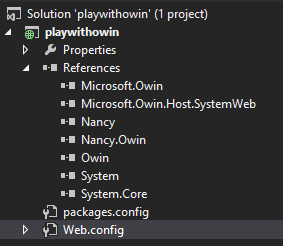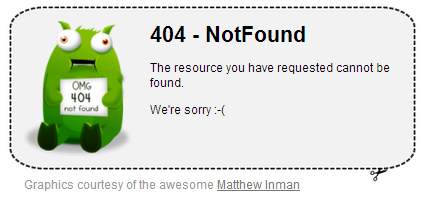I was keeping my eye on OWIN for some time now (since Mark Rendle’s interview in DNR in 2011, when he complained about HttpRequest and HttpResponse being sealed in ASP.Net and spoke about OWIN as alternative). I like simplicity of this interface, and I also like that Microsoft listened to community and provided Katana, their implementation of it (so now you can also run OWIN apps on IIS). OWIN got to stage where it can be used for serious applications, there is already support for multiple frameworks, some of them being Nancy, Singalr and WebAPI, so you can now build pretty much anything on top of it, and being independent from IIS and all of its http modules, handlers etc has a lot of potential to perform better (given that you don’t need all of these features that asp.net provides, which is the case for most of applications). And those of you who tried testing your code dependent on System.Web, probably already know about OWIN. For just one good reason why to use OWIN, I would just like to quote one part of that interview:
the code’s maintainability is that less code between the TCP socket and your framework. It feels naturally like that’s a good thing and it’s just less code in your application, that’s less code to go wrong. If everything is handled through interfaces or delegates, then at any point in that pipeline you can inject something in a test environment; and as far as everything beyond that point is concern, that might as well have come from a TCP socket so you can create a dictionary of headers and you don’t have to patch in everything else.
quote from transcript on http://s3.amazonaws.com/dnr/dotnetrocks_0683_mark_rendle.pdf
I’m big fan of clean and simple code above all, and I hate additional layers, especially when they don’t provide any valuable abstractions (don’t get me wrong, ASP.Net provides many useful abstractions, and it is great framework, but sometimes there is just no need for all of that), sometimes you just don’t need all that infrastructure, actually I would say that most of applications don’t need it, especially today when more and more applications are running in browser, you just need as simple way as possible for your application to communicate to server.
So, as I always want to learn something and extend my skill set, I choose to put OWIN under my belt, as creating HTTP services which can be self-hosted (or in windows service, or in exe/scheduled task, or…) can come in pretty handy.
To get started with OWIN, I’m using Visual Studio 2013, it takes few simple steps:

This gives you choose template screen:

That gives new project that is (aside from plenty references) empty, it contains only web.config.

If you are not using Resharper, then you should :), but for this matter you can use some other extension to clean up unused references, that will leave your project with only System and System.Core. To get started with Nancy and Owin, use NuGet PM Console: Install-Package Nancy.Owin. That will also pull Nancy, as dependency. That puts Nancy, Owin, and Nancy.Owin into references. After that, project looks like this:

To run app, you need to host it somewhere. As most convenient way to develop is to run it from Visual Studio, it is necessary to add hosting adapter to host OWIN in IIS (or Express version that is used by Visual Studio):
Install-Package Microsoft.Owin.Host.SystemWeb
This adds Microsoft implementation of Open Web Interface (aka Project Katana) and hosting adapter which contains OwinHttpHandler used to handle http requests and pass them to OWIN. These are in Microsoft.Owin, and Microsoft.Owin.Host.SystemWeb libraries, respectfully.
After these few steps, it is possible to run this frame for application:

As this is not MVC application from VS template, this is expected, but it is very nice and descriptive exception, and it makes clear what is next step to do to get it working: it is necessary to either add OwinStartup attribute to assembly, or to create Startup class with Configuration method. As “Startup.Configuration” sounds explanatory, I will do that:

Configuration method’s signature is documented in Katana documentation, but you don’t even have to open it, if you don’t make it like this, another exception will tell you to do it. This part is actually what is this whole post about. This single line of code in Configuration method is actually all you need to do to run Nancy on OWIN.
It is worth noting that IAppBuilder is not official part of OWIN interface, but part of Katana itself, and if you decide to run your app on something else, then it may be necessary to change way how application starts.
UseNancy extension method comes from Nancy.Owin package, and it is just wrapper around builder.Use:
If you take a look into NancyOwinHost, you will see that it is just an adapter to Owin infrastructure, similar to NancyHandler for Asp.Net, but difference is that handler gets to work with HttpContextBase (which is abstract, and not very simple to mock/fake), while NancyOwinHost gets Dictionary<string,object> which is how http request is represented in Owin. It is lower level of abstraction, meaning it is much closer to the metal, and if you don’t need all of the fancy stuff in HttpContext, then it is likely that this is going to perform better, with less resources.
Running application now gives default Nancy 404 response:
Ok, Nancy gets request, and as there is nothing to process it, returns not found.
To return something useful to client, we need a “controller”. In Nancy, that is Module:
This is how handler for get request for root path (“/”) is defined in Nancy. I like it, as to me is much more expressive than “Index” ActionResult.
As I’m returning view named “home”, I will create it in “Views” folder (standard convention, Nancy will look for it there):

And result is:

So, our web site in .NET without System.Web is live:

This is yet far away from being an application, but building one using Nancy and Owin is not so much different than using MVC and Asp.Net. It is always useful to learn other ways to do same thing, because that gives you another perspective and ability to see things you missed before.
I end this post here, and next step will be more about Nancy, and how to add some script and css resources and see how to serve them to browser, and what is different in OWIN than in Asp.Net, as standard bundling libraries reside on top of System.Web and won’t work here.
I pushed source code for playwithowin project to github. You will have to restore NuGet packages as only code is there, so don’t go offline until you build it once 🙂
UPDATE: Next post is now published


